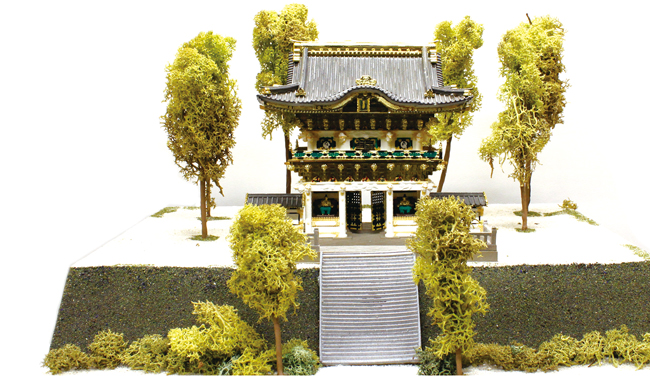
当たり前に日本人として生きてきた。でも海外に出てから、日本について何も知らないことに気が付いた。そこで、日本が世界に誇る世界遺産について建立年順に勉強しようと思う。興味がある人も、そうでない人も、しばしお付き合いを。
I’ve lived my whole life as a Japanese person, but when I went overseas I realised I know practically nothing about Japan. So now I’m learning about Japan’s World Heritage Sites, from oldest to newest. Those who are interested, and even those who are not, come along for the ride.

撮影協力 / メルボルン総領事館 Thanks to the Consulate-General of Japan, Melbourne
○○○○○ 東照宮: 家康を祀る瓊宮瑤台のような神社 ○○○○○
今回は、1999年に『日光の社寺』のひとつとして世界文化遺産に登録された、栃木県日光市にある神社、東照宮(とうしょうぐう)を紹介します。東照宮は、江戸幕府初代将軍の徳川 家康(とくがわ いえやす)を神格化した東照大権現(とうしょうだいごんげん)を祀る神社で、日本全国の東照宮の総本社的存在。そのため、他の東照宮と区別する意味から、地名を付け日光東照宮と呼ばれることが多いです。東照宮を含む日光の社寺は、“古来の神道思想に基づく信仰形態は自然と一体となった宗教空間を創り上げ、今なお受け継がれていること”や、“近代日本の神社建築の発展の様子を今に伝えていること”が評価され、登録されました。更に、東照宮に関しては“芸術家による人類の創造的才能を表す傑作である”ことも評価されています。
1617年、家康本人の「一周忌が過ぎてから日光山に小さな堂を建てて勧請(かんじょう: 神仏の来臨や神託を祈り願うこと)せよ」という遺言により、東照社が誕生しました。「なぜ日光山に?」と、思った方がいるのではないでしょうか? ハイ、私も思いました。調べてみたところ、日光山は生前の家康や徳川家に特別なゆかりがない土地。しかし、日光山は関東武士の尊崇を集めた山岳信仰の霊場であり、更に江戸から見て北極星の輝くほぼ真北にある場所。そこで神として祀られることによって、徳川幕府の安泰と日本の恒久平和を守ろうとしたといわれています。
1634年には、3代将軍 家光(いえみつ)が日光社参し、1636年の21年神忌に向けて寛永の大造替(かんえいのだいぞうたい)が始められ、現在の荘厳な社殿への大規模改築が行われました。陽明門(ようめいもん)をはじめとする国宝8棟、重要文化財34棟を含む55棟の建造物の殆んどが、この時に造られました。また建物には、全国各地から集められた名工によって漆や極彩色が施され、柱などには数多くの彫刻が飾られています。個人的に「豪華で確かに凄いけど、ゴテゴテし過ぎ。もう少しスッキリすれば良いのに…」と思っていたのですが、これらの装飾は単なるデザインではなく、信仰形態や学問、思想が表されているそうです。あぁ、奥が深い。ちゃんと意味があったなんて知りませんでした。
東照宮にある動物・霊獣の彫刻は全部で26種類。その中でも有名なのが、東照宮の三彫刻といわれる、見ざる・言わざる・聞かざるの『三猿』、江戸時代に活躍した天才絵師 狩野 探幽(かのう たんゆう)が下絵を描いたとされる『想像の象』、 伝説的な彫刻職人 左 甚五郎(ひだり じんごろう)作とされる『眠猫』です。でも最多登場する動物は虎。木彫38体・41頭の彫刻があります。これは家康の生まれた年が1542年の寅年で、生まれた時間も寅の刻(午前4時)だったからとか。
動物以外でおもしろいなと思ったのは、陽明門にある「グリ紋」と呼ばれる渦巻き文様が彫らた12本の白い柱。12本のうち1本だけ、渦巻きの紋様が意図的に逆に彫られた柱があります。この柱は「魔除けの逆柱」と呼ばれていて、“完璧なものは、その瞬間から崩壊が始まる”とされていたことから、 魔除けのためにあえて1ヶ所だけ仕様の異なるところを作ったといわれています。装飾の意味を知ると見方も変わりそうですね。平成の大修理も順調に進み、輝きを取り戻した社殿を拝観することができます。また、今年は家康没後400年の節目にあたり、四百年式年大祭が盛大に行われました。
次回は、1996年に世界遺産に登録された、広島県の原爆ドームをご紹介します。
○○○ Toshogu: a palace-like shrine to Tokugawa Ieyasu ○○○
This time we cover Toshogu, a shrine in Nikko, Tochigi Prefecture. It is one of the ‘Shrines and Temples of Nikko’ added to the World Heritage list in 1999. Shrines called ‘Toshogu’ are dedicated to the worship of Tosho Daigongen, the deification of Tokugawa Ieyasu (the first Tokuguwa shogun). Because there are many shrines with theToshogu name, this one is often called Nikko Toshogu to distinguish it. It is perhaps the most significant of all such shrines. Toshogu, along with the other Shrines and Temples of Nikko, was World Heritage listed due to its high regard as ‘a sacred space built in harmony with nature in accordance with ancient Shinto beliefs that continue to survive today’ and ‘show the development of modern-day Shinto shrine architecture’. It is considered ‘an artistic masterpiece of human creativity’.
Toshogu was established in 1617 in accordance with Ieyasu’s will, in which he wrote, ‘One year after my death, build a little shrine on the mountain Nikko-san to pray for the coming of gods and buddhas.’ I expect some of you are wondering, ‘Why at Nikko-san?’ I did too. When I looked it up, I found no special connection between the area and the Tokugawa clan before then. However, Nikko-san was revered as sacred ground by the samurai of Kanto, who practiced mountain worship, and moreover seemed in the Edo period to be where the North Star shone. They say that enshrining Ieyasu there as a god was an attempt to ensure security for the Tokugawa shogunate and everlasting peace in Japan.
In 1634, the third Tokugawa shogun Iemitsu visited the Nikko shrine, and in 1636 the Kan’ei period renovations began, transforming it into the impressive main shrine we see today. Nearly all the shrine’s 55 buildings (including 34 important cultural properties and 8 national treasures) were constructed at this time. Lacquering and rich colouring was provided by craftsmen from all over Japan, and the pillars and such were decorated with numerous carvings. Personally, I had thought Toshogu to be certainly splendid, but also rather over the top; apparently though all that ornamentation isn’t merely aesthetic, but rather represents religious figures, scholarship, and ideology. Sorry – I didn’t know it all had a proper meaning!
Perhaps most famous of the carvings at Toshogu are the ‘Three Wise Monkeys’ (who ‘see no evil, speak no evil, and hear no evil’); the ‘Imagined Elephants’, based on a design by Edo-period artistic genius Kano Tan’yu; and the ‘Sleeping Cat’ by legendary sculptor Hidari Jingoro. However, there are 26 types of animals depicted at Toshogu. Tigers are the most numerous, with 38 carvings and 41 sculptures. This is because Ieyasu was born in 1542 (the year of the tiger) at 4am (the hour of the tiger).
Apart from the animals, a feature I found interesting is the twelve white pillars with spiral engravings that are part of the Yomeimon. On one of the pillars, the spiral design has been carved the opposite way to all of the others. It is called the ‘Reverse Pillar Talisman’, and is an intentional imperfection – because ‘a perfect thing can only decay thereafter’. The imperfect pillar is a talisman to protect the shrine. Knowing the meaning of decorations can really change how you look at them, can’t it? The current Heisei period renovations are going well, and we will soon be able to see the main shrine restored to its former brilliance. Also, this year is the 400th anniversary of Ieyasu’s death, so a grand festival and extravagant celebrations were held to mark the occasion.
Next time, we cover the Hiroshima Peace Memorial (Genbaku Dome), World Heritage listed in 1996.

